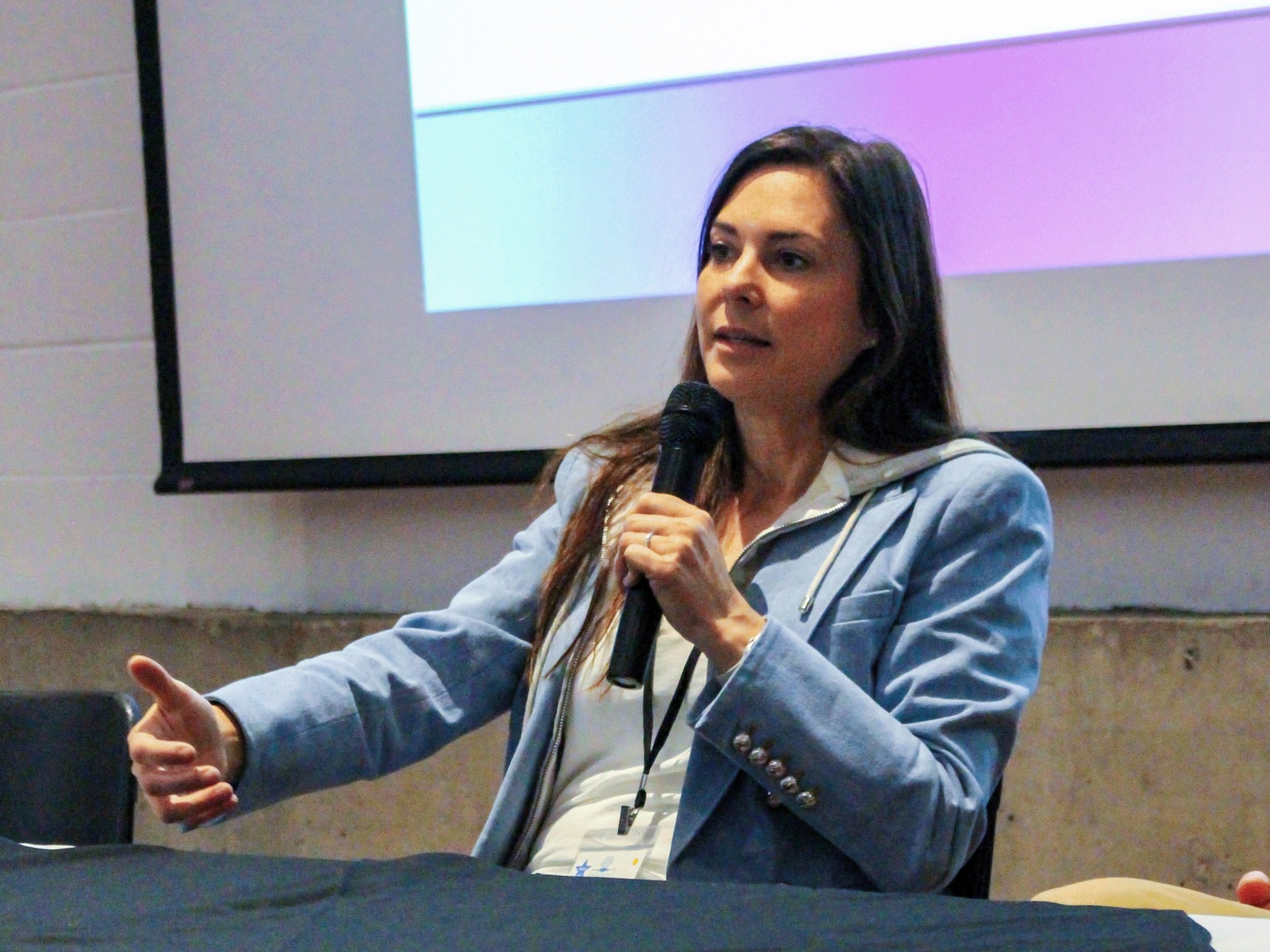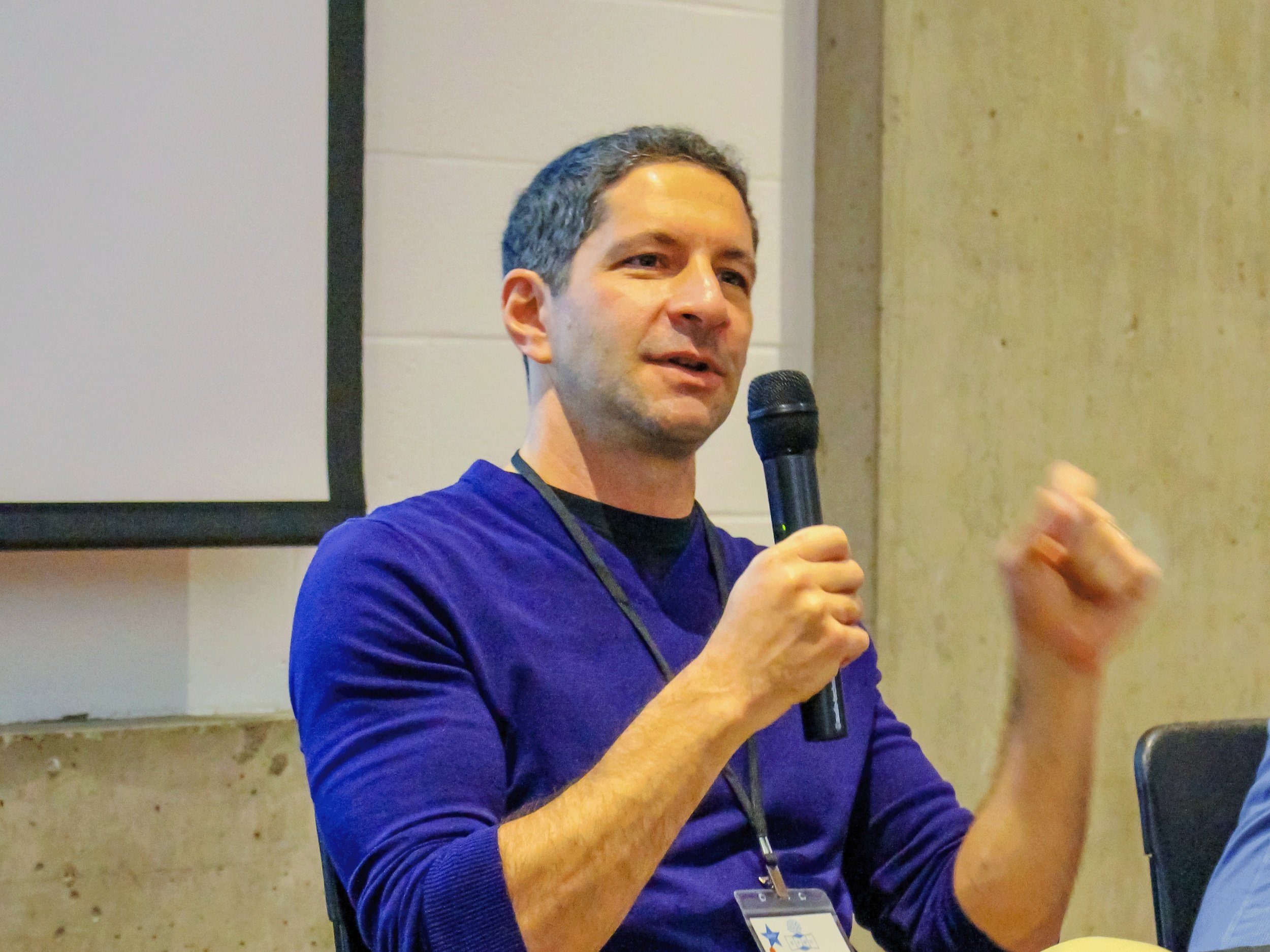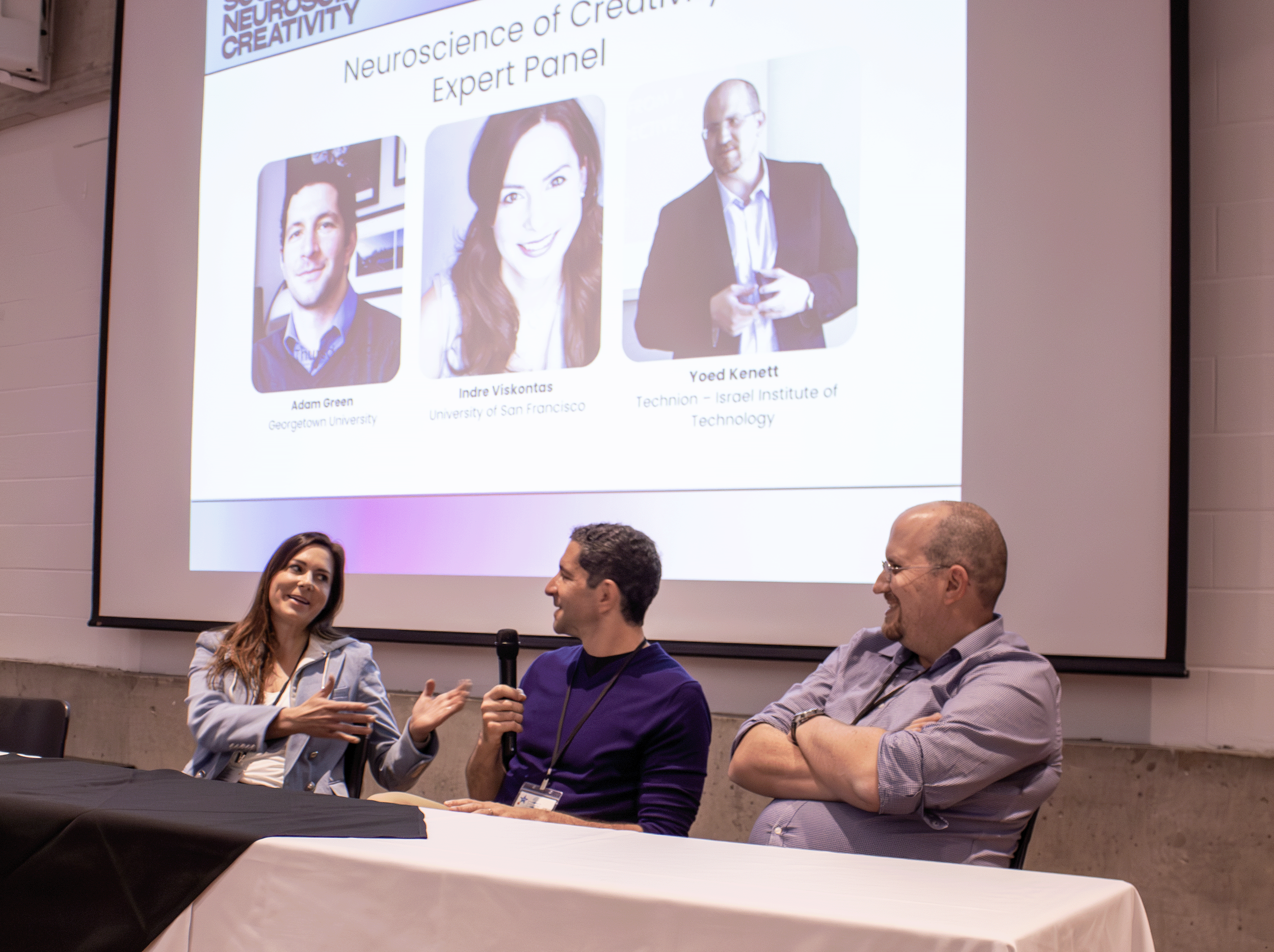Current Innovations and Future Trends in Neuroscience of Creativity: Views from Three Experts
Indre Viskontas, Yoed Kenett, and Adam Green are heavy hitters in the neuroscience of creativity, and they each have very different approaches, areas of expertise, and perspectives.
Indre Viskontas
University of San Francisco
Yoed Kenett
Technion Israel Institute of Technology
Adam Green
Georgetown University
At SfNC2024, we asked them to share their views on the state of our field, the research directions and methods they’re most excited about, and what they think are the most important questions we should be focusing on in creativity science going forward. They also offered their best advice for trainees and early-career researchers.
Though they sometimes disagreed on the specifics (or at least pretended to), we came away from the session with tons of great insights about where to focus our attention to make progress in our discipline and so many reasons to be excited about the future.
Question 1: What do you think is the biggest gap in our current understanding of creativity? And what do you think the next big question is for our field to address that would have the biggest impact?
Indre: I think the next big thing for our field is the need to talk about creativity in the way that laypeople think of it, which is very much tied to the arts: whether it’s visual art, or performing art, or music, etc. We should be answering questions about what it means to be professionally creative, and we need to frame and communicate this in a way that’s relevant to creative professionals and anyone who consumes creative products in these domains.
We need to turn our attention to applying neuroscience to answering some of the fundamental questions that people in the arts are interested in, such as how to get more people to visit cultural institutions and patronize the arts? How can we help performers be better at their job? How can we help people see the creative arts as something fundamental to education, health, and wellness so that it’s consistently funded in schools?
I’m involved in the NeuroArts movement, and right now we’re in this zeitgeist moment where there’s a lot of interest in the intersection of neuroscience and the arts. But of course attention spans are limited, so if we don’t prove that neuroscience research is meaningful to them in some way, we’re going to lose this opportunity and they’re going to move on to something else.
Adam: First off, I want to reflect on the fact that the purpose of SfNC is exactly this – to identify and coordinate how to fill these gaps. When SfNC was started 9, 10 years ago, our goal at the time was to unify the disparate research going on so that we could form a coherent field. And now we’re at a point where it’s even possible for us to recognize priorities that we should systematically tackle together. We’re now talking about things in a unified space.
But to answer your question, I think we need more detail. We talk about “creativity” in a general sense, but in order to make progress, particularly with enhancing creativity, we need to be able to parse the different components of what we mean by creativity in different contexts as they relate to the outcomes we care about.
For example, we know that being creative is helpful in STEM domains, but it’s very difficult to actually make use of or improve creativity in STEM if we don’t know what aspects of creativity actually matter and how to influence them. Right now we measure “creativity” at different points in education: how it goes up or down in different years of schooling, or at different ages, or in different school districts, or countries. But the more difficult question that we should prioritize is how can we integrate creativity into curricula, that is – how can we plan and train for creativity in a deliberate way, and help students learn how to be creative as a mode of approaching whatever it is that they’re studying. That’s a huge gap right now, and it requires a more specific parsing of the components of creativity we’re trying to influence through STEM education.
The second gap I see is that, if we’re going to understand how to improve creativity at the neural level, the details of the individual matter. Something that’s confusing us now is that although we have a basic mapping of some of the neural circuitries and architecture involved in creativity, when we try to intervene on the brain to influence it such as through neuromodulation, neurofeedback, etc., the results tend to be somewhat muddy. And that’s because what we’re seeing at the group level doesn’t necessarily tell us very much about how individual brains operate. We need real-time and individuated biomarkers.
The last thing is that we need to stop talking about novelty and utility so much as the only things that matter for creativity. They describe the desired outcomes for creative products, not the creative process, and what we’re actually studying a lot of the time in the neuroscience of creativity is the creative process as humans do it. [see this recent paper by Adam & Yoed in CRJ on the process definition of creativity]
Yoed: The first huge gap I see is that the term creativity is holding us back. In classes I teach on creativity, I try to get my students to stop using the term creativity because it’s too abstract and too coarse. We need to break this concept apart and then put the pieces of the puzzle back together in new ways so we can create new terminology and a new understanding of how it relates to and describes so many different things.
The second thing that I think is critical to address is how context changes creativity. We tend to ignore context in the lab, but it has a huge influence on what creativity looks like in any given situation as well as the cognitive processes involved.
The last thing I think is critical to consider is domain-specificity and domain-generality in creativity. So far, we’ve tended to focus on general common mechanisms involved in creativity, such as thinking and memory, etc. Now we should be interested in more fine-tuned mechanisms that may differ in different forms of creativity, and in different contexts. Understanding the more domain-specific and context-specific processes that are brought to bear in different kinds of creative activity will also help us develop better ways to enhance creativity through behavioral interventions and tools like neuromodulation.
Question 2: If you had unlimited grant funding, millions of dollars, and infinite budget to pay research assistants and participants, how would you approach studying these big questions. In other words, what is your dream project?
Yoed: My aim would be to do population-level creativity assessment. We now have so many tools to access so many people, such as through crowd-sourcing. Why are we still collecting 50 subject samples? We could be measuring ten million people across diverse ages, countries, languages, cultures, and levels of education. At this point it’s clear how we could collect much, much larger samples, we’d just need the money to make it happen.
Adam: Yoed went macro, I’m going to go micro and say that I think it would be fascinating to work with a group of individuals long enough to figure out the individual susceptibility of different brains to different neural interventions. We could more accurately figure out whether and why different forms of stimulation, to different sites in the brain, during different tasks, are more effective for different individuals. If we did this in a systematic way and collected enough data from enough subjects, I bet that what we’d find is that there are a few reliable categories or sets of neural profiles for creativity that would really help guide our neural and cognitive theorizing.
Indre: So while Adam’s lab is testing a few people long enough to figure out their individual neuro types, I’m going back to the macro, which for me would involve figuring out how we can optimize the joy and feeling of self-actualization that happens when we experience a great work of creativity or when we create ourselves. Where does that joy come from? It’s similar to flow but it goes beyond flow. It’s about that soul-feeding nature of creativity that reminds us that we are individual beings that matter.
The way I’d go about this is by doing a longitudinal study with a bunch of different interventions, such as producing art or interacting with different forms art in various ways, etc., and I’d track how different people respond to these different interventions over time so we can figure out exactly under which conditions this “soul-feeding” happens. This could help us maximize human flourishing and well-being even in the dystopian all-virtual world we seem to be heading towards.
Question 3: Now given realistic constraints, what do you think are some things that we could all be doing right now, going forward, that would improve how we study creativity, even if it’s just tweaking our approach or changing our perspective on some issue? What methods or tasks should we be using (or stop using) to do better science? Basically, what I’m trying to say is: when are we going to stop asking people how many uses they can think of for a brick?
Adam: One thing we are just starting to tap into is the value of creativity assessment as a tool for measuring potential in education. A really exciting and appealing aspect of using creativity assessment in schools is that we can show that creativity predicts future performance and is much less associated with factors like race and socioeconomic status than traditional performance metrics.
Another promising area to focus on is identifying real-time neural markers of different creative brain states. For example, I’m thinking of Yuhua Yu’s work showing how differences in EEG spectral power volatility can predict whether someone will go on to solve a problem insightfully or analytically a few seconds later. Biomarkers like that are great because they’re a cheap, practicable way to identify in real-time when individuals are being more creative or have the potential to be creative based on their brain state. We can use biomarkers like that to improve the efficacy of our behavioral or neural interventions aimed at improving creativity in real time.
Yoed: One thing that I’m really pushing for is the standardization of creativity assessment and scoring through quantification. I believe that quantitative science is better science. Recently we’re seeing many new models and initiatives being developed for automatic scoring of creativity, many coming from Roger Beaty’s lab. These are all important breakthroughs and very promising, though right now they all focus narrowly on quantifying whether some creative product is novel and appropriate. Going forward we should also aim to include other dimensions of creativity and think about how to automatically quantify aspects not just of creative products but also of the creative process, person, etc.
Lastly, I agree that we need to move towards more individualized markers of creativity but also to identify dynamic markers of creativity over time. This may involve developing more advanced methods to study the brain as it engages in creative activity over time.
Indre: I’ll give a plug for equity. We often don’t make our studies accessible to those who have disabilities or those who are neurodivergent. We should be thinking about creating tools that are more equitable by working with people who are part of these communities. I think we’re missing out on understanding a lot of the ways that the brain is creative because we’re failing to include different types of brains in our samples and we’re not making equity a central tenet of how we conduct research.
Question 4: You all mentor students and have trainees, and a big part of what the Society does is provide a platform and serve as a professional network to help develop the future scholars in our field. What advice do you have for trainees at the beginning or early stages of their career for what the future looks like?
Indre: While we may not go into academia for the money, I think it’s important to be able to predict where the money is going to be 5 or 10 years from now, and I think it’s safe to say that it might not all be from government institutions, especially outside the US. There are lots of private companies, tech companies, etc., who looking to invest in creativity. That money is probably going to dwarf the amount of funding that we can get from public institutions. Further, we simply know that there aren’t going to be enough professor jobs for everyone graduating with a PhD right now, but there’s going to be a huge need for PhD scientists out in the world. So thinking strategically, you might consider how your work could make an impact in private industries. Most of these companies at least profess to want to make the world a better place, it’s not just about the bottom line. So as you move through your training, you might want to think about how you could position yourself and your research to make a difference in those areas.
Adam: I’m going to disagree (or at least pretend to) because although there’s a lot that’s true about what you just said, I think it’s important for the soul of our field to make sure we show students that there’s still a path forward in academia. In my lab we collaborate with a lot of private sector companies, and it’s not that it can’t be a great path for students to take. These companies do say they want to make the world a better place, they’re interested in the ideas and they’re excited by the research, but it still has to go somewhere that’s profitable. That’s not a value judgment. It’s just to say that if the academic side of our field is swallowed up, we will lose a lot of the best ideas and the motivation of our talent. So, for the sake of our trainees I think we need to model that there’s a path forward in academia (and there is) and encourage and support them to pursue that path.
Yoed: I also actually slightly disagree with both of you, because I think the future is very bright. From the time since I started my PhD, it’s amazing how far we’ve come. I think this is the best time to be in this field.
My advice is that since creativity is a complex and multidimensional construct, focusing on developing multidisciplinary skills is what can bring an edge to your research and how you’re positioned. I’d encourage trainees to develop a range of technical and research skills such as computational modeling and programming, etc., but also being able to converge and synthesize your skills across empirical, cognitive, and computational perspectives in academia and industry. Another thing is being aware of the tidal wave of AI that may overwhelm us all. The people who’ll be able to use AI in creative ways and ride that wave, to use it as a tool to increase the complexity of your results are going to be most successful, and that’s where I think the future of jobs is heading towards.
“You’re also right” “Well, you’re also right!”
If there’s one thing all three panelists agreed on, it’s that the future of the neuroscience of creativity looks very promising indeed. SfNC members can watch the full panel recording on CrowdCast.







